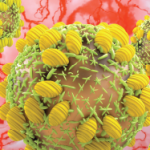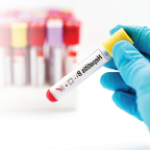
Three presentations at the ACR 2013 State-of-the-Art Clinical Symposium, held April 20–21 in Chicago, focused on vasculitis, with speakers giving the latest information about diagnosis and management of Behҫet’s syndrome, viral infectious arthritis, and central nervous system (CNS) vasculitis.
Behҫet’s syndrome, which is most common in the Mediterranean basin, Korea, and Japan, has distinct features and is “an interesting disease because it doesn’t fit into any category,” said Yusuf Yazici, MD, director of the Seligman Center for Advanced Therapeutics and Behҫet’s Syndrome Center at New York University Hospital for Joint Diseases in New York City.
“The disease burden decreases with the passage of time, and the occurrence of all manifestations seem to decrease in frequency, except for CNS disease and major vascular pathology,” Dr. Yazici said, adding that the most feared complication is pulmonary artery aneurysm.1 For the majority of patients with Behҫet’ssyndrome, the disease will have a gradual onset in the second to third decade of life. Men and women have equal prevalence of the disease, but it tends to be more severe in men, particularly if they get the disease earlier in life.
Symptoms of Behçet’s Syndrome
Most patients present first with oral ulcers, Dr. Yazici said. Minor aphthous ulcers are common and affect the inside of the lips, gingiva, cheeks, and tongue, and they usually heal within 15 days with no scarring. The disease is also marked by genital ulcers, with papules or pustules that ulcerate quickly and have a punched-out appearance, and they can lead to secondary infections. In men, the ulcers are usually on the scrotum; women can be unaware of genital ulcers unless a gynecologic examination is performed. Other skin manifestations include acne-like lesions on the upper back, arms, and buttocks. Acne and arthritis are associated in patients diagnosed with Behҫet’s.
Eye disease, with hypopyon seen in about 20% of cases, is the main focus because Behҫet’s is the leading cause of nontraumatic blindness, after diabetes, in Japan and Israel. Eye disease tends to get milder with time, and major manifestations of symptoms are rare five years after diagnosis. “It is important that eye disease be treated quickly,” Dr. Yazici said.
About 60% of patients will have nodular lesions, with 50% of those erythema nodosum–like lesions and 50% superficial thrombophlebitis. “Clinically, presence of superficial thrombophlebitis is important because it is associated with more severe vascular thrombosis and aneurysms,” he said. There can be nervous system involvement with Behҫet’s, generally either parenchymal disease or dural sinus thrombosis.
Immunosuppression is the first choice for therapy for major organ involvement. Colchicine is prescribed most often for mucocutaneous involvement. A 2.5-mg/kg daily dose of azathioprine can be prescribed to treat eye disease, to lessen its severity and the frequency of hypopyon attacks, and to preserve vision. It can also be used for oral and genital ulcers and for arthritis. Because the onset of action is slow, often at least three months, “we don’t give up on the drug until six months. You have to take the right dose for the appropriate amount of time,” Dr. Yazici said.
Risk of HCV and HBV in Rheumatic Diseases
Leonard Calabrese, DO, professor of medicine in the department of rheumatic and immunologic diseases at Cleveland Clinic Lerner College of Medicine, focused his presentation on viral infectious arthritis on two viruses that are comorbidities in rheumatic disease: hepatitis C (HCV) and hepatitis B (HBV). HCV, an emerging pathogen, has now overtaken HIV in annual mortality and is the most common blood-borne infection in the United States, “making the point that this is serious business,” Dr. Calabrese said. The incidence rate has prompted the Centers for Disease Control and Prevention to advocate birth-cohort screening of everyone born from 1947 to 1965. Patients at high risk include men who have sex with men, and people who abuse drugs, use injectable drugs, have multiple sexual partners, or have intimate contact with HCV-infected partners.
About 15% to 20% of people exposed to the virus will overcome and recover from the initial infection, but the remainder will have chronic and persistent infection over several decades, and about 25% of those will develop cirrhosis, end-stage liver disease, or hepatocellular carcinoma, and will die without a liver transplant. People with a chronic infection may have nonspecific symptoms, such as fatigue, depression, and abdominal discomfort. Those with advanced chronic infection may have portal hypertension with ascites, encephalopathy, gastrointestinal bleeding, jaundice, and decompensation.
“Screening patients and finding HCV will mean you have done the biggest favor to the patient, more than treating their rheumatoid arthritis [RA],” Dr. Calabrese said. Any patient diagnosed with HCV should be evaluated by a hepatologist and assessed for therapy. If appropriately treated, 75% of patients can be cured, and that cure rate is expected to increase in the next two years.
Patients with RA and HCV infection may need remittive therapy, with the biologic monotherapy etanercept a reasonable treatment. A baseline liver biopsy should be obtained, with a follow-up biopsy in three to five years.
HBV, a de-emerging pathogen, is more complicated for patients with RA because of the threat of reactivation. Reactivation is potentially fatal but preventable, and it can occur after immunosuppression is either decreased or eliminated. This reactivation syndrome can occur in patients on low doses of methotrexate and prednisone, and it is increasingly reported in patients on biologic therapies. In the setting of HB surface antigen (HBsAg) positivity, treatment with a tumor necrosis factor inhibitor can lead to reactivation in as many as 40% of patients, Dr. Calabrese said.
All patients with a past history of HBV are at risk of reactivation, regardless of the presence or absence of serologic markers. Those at highest risk have chronic HBV infection, are HBsAg positive, and have high HBV DNA. At a bit lower risk are patients HBsAg positive and with either low or nondectable HBV DNA at baseline, he said. “My recommendation is that all patients commencing immunosuppressants and immunomodulatory therapies should be screened.”2
Diagnosing CNS Vasculitis
In his talk on CNS vasculitis, Dr. Calabrese noted that it is a treatable disease that can be diagnosed by presence of the following:
- A neurological sign or symptom (headache, stroke, seizure) that remains unexplained after a vigorous diagnostic workup;
- Some evidence of vascular disease in the brain, demonstrated by biopsy or angiography; and
- Exclusion of conditions capable of producing secondary arteritis or mimicking the angiographic features of arteritis.
Correct diagnosis is based on seven “rules of thumb,” he said. The first is that there is no clinical finding or set of findings of sufficient pretest probability to secure a diagnosis of primary angiitis central nervous system (PACNS) vasculitis.3 However, some signs can be definitive and, if present, should be elevated in a differential diagnosis: elevations of cells and proteins and normal glucose for three to six weeks after chronic infection and malignancy; recurrent focal deficits; constellation of both focal signs; and diffuse cortical impairment/neurological dysfunction.
Other tips for diagnosis:
- A lumbar puncture is the key laboratory test and should never be omitted unless there is some absolute neurosurgical contraindication.
- Normal magnetic resonance imaging (MRI) has a very high negative predictive value. “A combination of a normal MRI and normal lumbar puncture virtually rules out this diagnosis 100% of the time,” Dr. Calabrese said.
- No angiographic picture in the brain is 100% specific to the diagnosis of CNS vasculitis.
- Biopsy is an imperfect diagnostic tool, with a sensitivity of 75% or 80%, but it can rule out other conditions. “A nondiagnostic biopsy that has shown no evidence of infection or malignancy often is enough for me to be confident about investing in highly immunosuppressant therapy,” Dr. Calabrese said.
- Rule out infection and malignancy, and screen for viral infections, including HIV, HCV, and others.
- If the patient does not respond or progresses on cyclophosphamide and glucocorticoids, suspect an alternative diagnosis rather than refractory disease.
“Ask yourself at the end of your next consult whether any of these red flags are present,” Dr. Calabrese advised. “Was the diagnosis made in the absence of a lumbar puncture? Is the diagnosis made on angiogram with a normal lumbar puncture? And if the patient is not responding to aggressive therapy, reconsider the diagnosis.”
Kathy Holliman is a medical journalist based in New Jersey.
References
- Hamuryudan V, Er T, Sevahi E, et al. Pulmonary artery aneurysms in Behҫet’s syndrome. Am J Med. 2004;117:867-870.
- Calabrese LH, Zein NN, Vassilopoulos D. Hepatitis B virus (HBV) reactivation with immunosuppressive therapy in rheumatic diseases: Assessment and preventive strategies. Ann Rheum Dis. 2006;65:983-989.
- Salvarani C, Brown RD Jr., Calamia KT, et al. Primary central nervous system vasculitis: Analysis of 101 patients. Ann Neurol. 2007;62:442-451.

